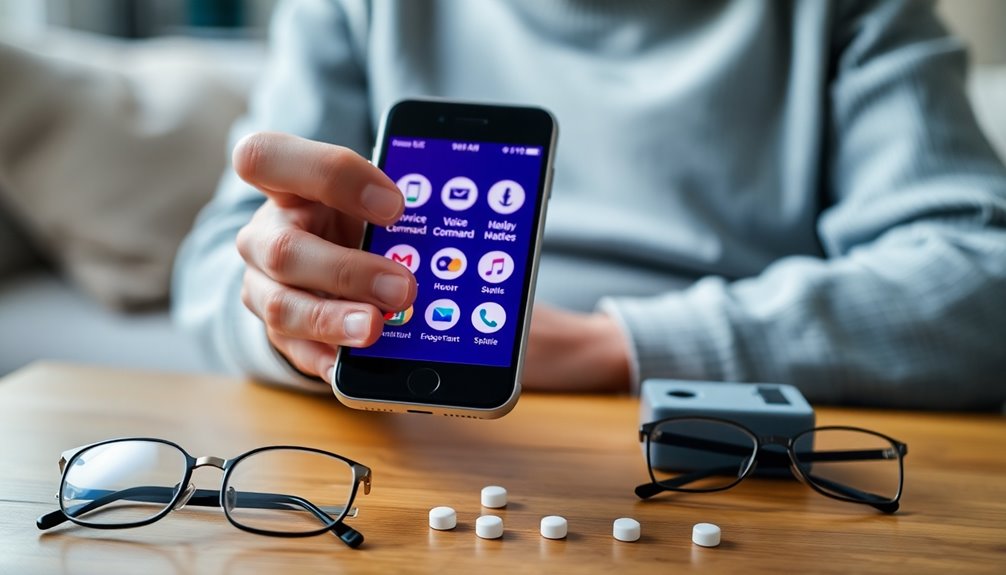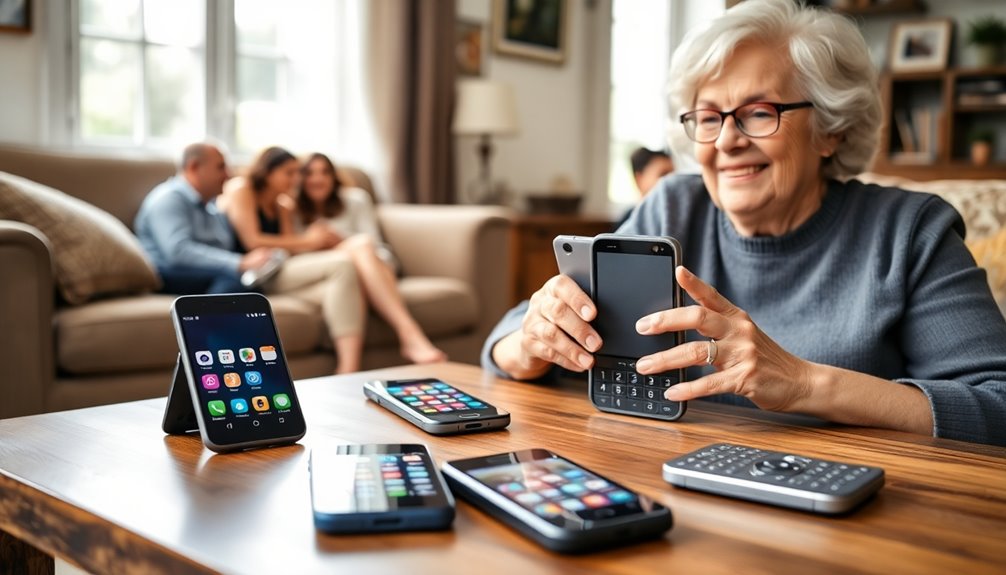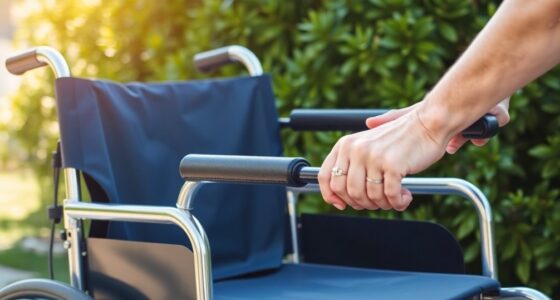When looking for the best phones for the elderly in 2025, I recommend options like the Serene Innovations Amplified Big Button Landline Phone and the VTech SN5147. They’re easy to use and have features such as large buttons, clear audio, and emergency SOS buttons. I’d also consider the 4G Big Button Cell Phone for its portability and essential functions. If you want more insights on specific models and their features, there’s plenty more to explore!
Key Takeaways
- Basic mobile phones and amplified landline options prioritize simplicity, featuring large buttons and clear sound for easy communication.
- Multifunctional desktop phones with photo memory dialing enhance accessibility by allowing seniors to call contacts by recognizing images.
- Long battery life and emergency features, like SOS buttons, ensure reliable communication and quick access to help when needed.
- User-friendly designs, including tactile indicators and high-contrast buttons, improve usability for seniors with visual or mobility challenges.
- Compatibility with hearing aids and adjustable volume controls provide clearer sound quality for seniors with hearing difficulties.
Serene Innovations Amplified Big Button Landline Phone for Seniors
When it comes to finding the best phone for seniors in 2025, the Serene Innovations Amplified Big Button Landline Phone stands out for its thoughtful design aimed specifically at individuals with dementia or cognitive impairments. I love its 26dB amplification, making conversations clear and loud enough to hear. The large buttons and photo speed-dialing feature help users quickly connect with loved ones. Plus, the ringer volume reaches an impressive 85 dB, ensuring no call goes unnoticed. This phone’s simple functionality and adjustable settings cater to various needs, making it a top choice for seniors seeking ease and accessibility in their daily communications.
Best For: Seniors with dementia, hearing impairments, or cognitive and visual challenges seeking a user-friendly phone for daily communication.
Pros:
- Large buttons and photo speed-dialing enhance ease of use for those with memory impairments.
- 26dB amplification and 85 dB ringer volume ensure clear conversations and audibility for hearing-impaired users.
- Operates during power outages, providing reliable communication at all times.
Cons:
- Lacks a Caller ID feature, making it difficult to identify incoming calls.
- Some users report issues with static noise and low volume during calls.
- Programming memory buttons can be challenging for some users, requiring additional assistance.
VTech SN5147 Amplified Corded/Cordless Senior Phone
The VTech SN5147 Amplified Corded/Cordless Senior Phone stands out as an ideal choice for seniors or those with hearing impairments, thanks to its impressive 90dB extra-loud visual ringer. I love how the big buttons and large display make calling family easy, especially for those with visual challenges. The smart call blocker is a game changer, blocking annoying robocalls and allowing me to blacklist numbers effortlessly. Plus, the photo dial feature lets me program eight contacts with their pictures, making it even simpler to connect. Overall, it’s a reliable phone that enhances independence and communication for seniors.
Best For: Seniors or individuals with hearing impairments seeking an easy-to-use phone for enhanced communication.
Pros:
- 90dB extra-loud visual ringer and oversized buttons make it accessible for users with hearing and visual challenges.
- Smart call blocker effectively prevents robocalls and allows blacklisting of up to 1,000 numbers.
- Photo dial feature simplifies calling frequently dialed contacts by associating names and photos.
Cons:
- The cordless functionality may confuse some users due to multiple buttons and features.
- Battery life issues can arise if handsets are not kept charged regularly.
- Some users may find the setup and programming of features requires a bit of learning and understanding.
AT&T BL102-2 DECT 6.0 Cordless Phone with Answering Machine
If you’re looking for a phone that simplifies communication for seniors, the AT&T BL102-2 DECT 6.0 Cordless Phone with Answering Machine stands out with its smart call blocking feature. It automatically blocks unwanted robocalls, which I find incredibly helpful. The large, high-contrast display makes reading easy, and the audio assist enhances sound quality for clearer conversations. I appreciate the digital answering system that records up to 22 minutes of messages. Plus, the intercom feature allows easy communication between handsets. While it might have a bit of a learning curve, the benefits are definitely worth it for enhancing connectivity.
Best For: Seniors or individuals seeking a user-friendly cordless phone with advanced call management features.
Pros:
- Smart call blocking effectively eliminates unwanted robocalls.
- Large, high-contrast display and lighted keypad enhance readability for visually impaired users.
- Digital answering system records up to 22 minutes of messages, providing ample storage for important communications.
Cons:
- Some users report a complicated setup process that may be challenging for non-tech-savvy individuals.
- Issues with intercom functionality can cause frustration during use.
- Caller ID accuracy may be inconsistent, and some find the voice announcements annoying.
Panasonic Cordless Phone with Large Display and Big Buttons (2 Handsets)
Designed specifically for seniors, the Panasonic Cordless Phone with its large display and big buttons stands out as an excellent choice for those seeking simplicity and functionality. This phone features two handsets, making it perfect for multiple rooms. I love the clear 2.1″ display and the easy-to-press buttons. The volume boost guarantees I hear every call clearly, while the talking caller ID keeps me informed. Plus, the emergency flashlight is a thoughtful touch. With advanced call blocking and a user-friendly setup, it’s tailored for seniors like us. Overall, it’s a reliable option for staying connected with family and friends.
Best For: Seniors looking for an easy-to-use cordless phone with large buttons and enhanced sound clarity.
Pros:
- Large display and big buttons improve visibility and ease of use for seniors.
- Volume Boost feature enhances sound clarity, making it suitable for those with hearing impairments.
- Advanced call blocking capabilities help reduce unwanted telemarketing and robocalls.
Cons:
- Answering machine volume is reported to be low by some users.
- Limited range can cause static when the handset is used far from the base unit.
- Setup process may be slightly complicated for some seniors, leading to potential confusion.
C1+4G LTE T-Mobile Cell Phone for Seniors and Kids
For seniors and kids who need a reliable and easy-to-use phone, the C1+4G LTE T-Mobile Cell Phone stands out with its large, backlit keys and simple interface. I love the 1.8-inch color display that’s clear and easy to read, plus the SOS button that connects to emergency contacts instantly. The phone supports various features like Bluetooth, FM radio, and even up to 1000 contacts with speed dialing using photo IDs. With a battery life lasting up to a week, it’s perfect for everyday use. Overall, this phone is an excellent choice for those seeking straightforward communication without the complications of smartphones.
Best For: Seniors and kids who require a straightforward, easy-to-use mobile phone for communication.
Pros:
- Large, backlit keys and a simple interface make dialing and texting easy for users with visual impairments.
- SOS button for quick access to emergency contacts enhances safety and peace of mind.
- Long battery life of up to a week ensures reliability for everyday use without frequent charging.
Cons:
- Some users may experience challenges in setup and compatibility with specific networks.
- Concerns about the durability of the device have been raised by some users.
- Limited instructions provided may make it difficult for some seniors to navigate the phone’s features effectively.
VTECH SN1127 Amplified Corded Answering System for Seniors
The VTECH SN1127 Amplified Corded Answering System stands out as an ideal choice for seniors who struggle with hearing difficulties. Its 90dB ringer and 40dB audio booster guarantee I never miss a call, while the 8 photo speed dial keys make calling loved ones effortless. I appreciate the big buttons and high-contrast design that enhance visibility. The digital answering system with 22 minutes of recording time is handy, and slow message playback helps me understand every word. Although some users mention minor technical issues, the overall thoughtful design truly empowers me to communicate confidently and maintain my independence.
Best For: Seniors and individuals with hearing or visual impairments seeking an easy-to-use, amplified phone system.
Pros:
- Enhanced sound features with a 90dB ringer and 40dB audio booster for clear communication.
- User-friendly design with big high-contrast buttons and 8 photo speed dial keys for quick access to loved ones.
- Digital answering system with slow message playback and 22 minutes of recording time for improved message comprehension.
Cons:
- Limited ringer volume settings may not suit everyone’s preferences.
- Some users experience confusion with message retrieval when integrating with cell phones.
- Reports of occasional malfunctions, including issues with making or receiving calls.
Bark Phone – Safest Phone for Kids & Teens
When considering a phone that prioritizes safety for kids and teens, the Bark Phone A15 stands out with its robust monitoring tools. It alerts me to texts, emails, and over 30 social media platforms, scanning for risks like cyberbullying and online predators. The GPS tracking feature provides real-time location updates, which I find incredibly reassuring. Plus, the tamper-proof parental controls guarantee my kids can’t delete texts without my approval. Although some users mention the setup can be tricky and data plans can be pricey, I appreciate the peace of mind it brings when balancing freedom and safety for my children.
Best For: Parents seeking a safe phone option for their kids and teens that includes robust monitoring and parental controls.
Pros:
- Comprehensive monitoring tools that alert parents to potential risks like cyberbullying and online predators.
- Tamper-proof parental controls that prevent children from deleting texts without permission.
- Real-time GPS tracking for added peace of mind regarding children’s locations.
Cons:
- Setup process can be complicated and time-consuming for some users.
- Monthly data plans are considered expensive by certain customers.
- Mixed reviews on the installation experience, with some finding it frustrating.
SMPL Big Button Phone for Seniors (Model 56012)
Designed with seniors in mind, the SMPL Big Button Phone (Model 56012) stands out for its intuitive photo memory keys, making it incredibly easy for elderly users and those with cognitive challenges to connect with loved ones. I love the large buttons and adjustable volume, which make dialing and hearing calls a breeze. The visual flasher guarantees I never miss a call, and it works seamlessly with both landlines and VoIP. While some users noted issues with volume resetting, the overall feedback highlights increased confidence in communication. This phone is truly a game-changer for seniors needing simplicity and reliability.
Best For: Seniors, elderly individuals, and those with cognitive or dexterity challenges who need a simple and reliable phone for communication.
Pros:
- Easy-to-use photo memory keys for quick dialing enhance usability for seniors.
- Adjustable volume settings up to 85dB ensure clear hearing during calls.
- Visual flasher for call notifications helps users never miss an important call.
Cons:
- Some users reported issues with volume resetting unexpectedly.
- Programming difficulties can arise when setting up photo buttons.
- Wall mount compatibility may be problematic with common telephone jack plates.
Panasonic Amplified Cordless Phone (KX-TGM420W)
For anyone struggling with hearing loss, the Panasonic Amplified Cordless Phone (KX-TGM420W) stands out as an exceptional choice among the best phones for the elderly in 2025. With a volume boost up to 40 dB and ringer volume reaching 100 dB, it guarantees you won’t miss a call. The six voice tone settings enhance clarity, while the Slow Talk button adjusts speech in real-time, making conversations easier. Its large backlit display and buttons improve usability, and features like a talking caller ID and call block are invaluable. Overall, it combines functionality with ease of use, making it a top pick.
Best For: Individuals with moderate to severe hearing loss looking for a reliable and user-friendly cordless phone.
Pros:
- Volume boost up to 40 dB and ringer volume up to 100 dB ensure calls are heard clearly.
- Features like Slow Talk and six voice tone settings enhance speech clarity for better understanding.
- Large backlit display and buttons, along with the talking caller ID, make it especially suitable for seniors.
Cons:
- Some users have reported issues with headset compatibility affecting performance.
- Price may be considered high by some, despite the justified features.
- Call quality can vary in specific scenarios, leading to occasional dissatisfaction.
AT&T CD4930 Corded Phone with Digital Answering System
The AT&T CD4930 Corded Phone with Digital Answering System stands out for its extra-large, easy-to-read LCD display, making it an excellent choice for seniors. I love its hands-free speakerphone feature and the Audio Assist, which boosts volume for clearer conversations. The phone digitally records up to 25 minutes of messages, allowing me to easily manage calls. With large buttons and a backlit display, it’s incredibly user-friendly. Although it lacks alphabetical sorting for contacts, I appreciate the speed dial function. Overall, this phone combines simplicity with essential features, making it perfect for anyone seeking an accessible communication solution.
Best For: The AT&T CD4930 Corded Phone is best for seniors or individuals with visual or hearing impairments who seek a simple and accessible communication solution.
Pros:
- User-friendly design with extra-large buttons and a backlit display for easy visibility.
- Hands-free speakerphone and Audio Assist features enhance conversation clarity and convenience.
- Digital answering system records up to 25 minutes of messages, allowing for easy call management.
Cons:
- Limited directory capacity with no alphabetical sorting, making it challenging to locate contacts quickly.
- Weight of 2.42 pounds may be cumbersome for some users to handle.
- Potential confusion regarding area code functionality and audio assist settings, as noted by some users.
Big Button Phone for Seniors – Corded Landline Telephone
When I think about the best phone options for seniors, the Big Button Phone for Seniors stands out due to its one-touch dialing feature, which makes it incredibly user-friendly for visually impaired individuals. The large buttons are easy to see, and the ergonomic design guarantees a comfortable grip. With an amplified ringer and loudspeaker, it’s perfect for those with hearing impairments. While some users mention sound quality issues, many appreciate its simplicity and accessibility. Plus, the responsive customer support adds peace of mind. Overall, it’s a solid choice for enhancing communication among elderly users.
Best For: Seniors with visual or hearing impairments who need a simple and accessible communication device.
Pros:
- Large, clear buttons and one-touch dialing make it user-friendly for visually impaired individuals.
- Amplified ringer and loudspeaker cater to those with hearing impairments, enhancing communication effectiveness.
- Ergonomic design ensures a comfortable grip, making it suitable for seniors with grip or mobility issues.
Cons:
- Some users report sound quality issues, including buzzing noises during calls.
- The volume may not consistently reach the claimed 80 dB, particularly when using the speakerphone option.
- A few units may arrive defective, and there is a need for more speed dial buttons for convenience.
4G SIM-Free Mobile Phone for The Elderly
Designed specifically for elderly users, the 4G SIM-Free mobile phone stands out with its large 1.77-inch screen and oversized buttons, making it incredibly user-friendly. It features larger fonts, clearer menu icons, and loud speakers, ensuring clarity during calls. The SOS button provides peace of mind by allowing quick emergency calls to five pre-set numbers. With a robust 1800mAh battery, I enjoy up to 6 hours of talk time, plus it supports both base and direct charging. While some users faced connectivity issues, the overall simplicity and accessibility make it a great option for seniors needing reliable communication.
Best For: Elderly users seeking a simple, reliable mobile phone for basic communication needs.
Pros:
- Large 1.77-inch screen with oversized buttons for ease of use.
- SOS button for quick emergency calls to pre-set contacts.
- Long-lasting 1800mAh battery providing up to 6 hours of talk time.
Cons:
- Connectivity issues reported with some carriers, particularly AT&T.
- Mixed reviews on the functionality of the charging base and SIM card recognition.
- Some concerns about potential blacklisting or inconsistent performance in the U.S. market.
Multifunctional Desktop Telephone with Photo Memory Quick Dialing
For anyone seeking a user-friendly communication solution for elderly loved ones, the Multifunctional Desktop Telephone with Photo Memory Quick Dialing stands out as an excellent choice. This phone features nine photo memory quick dials, making it easy for seniors to connect with family and friends. The adjustable volume guarantees clear sound, while the hands-free function enhances comfort during calls. Constructed from durable ABS material, it’s built to last. Although some users reported static issues over time, many appreciate its simplicity and effectiveness. Overall, if you want a reliable option, this telephone could be just what you need.
Best For: This telephone is best for elderly users who need a simple and accessible way to stay connected with family and friends.
Pros:
- User-friendly design with photo memory quick dialing simplifies the calling process for seniors.
- Adjustable volume settings ensure clear sound quality, enhancing the overall calling experience.
- Durable construction from ABS material provides a high-quality appearance and longevity.
Cons:
- Some users have reported static issues and inconsistent performance after several months of use.
- Potential concerns regarding packaging quality and receiving returned or defective products.
- Limited warranty information may leave customers uncertain about long-term support.
4G Big Button Cell Phone for Seniors and Kids
The 4G Big Button Cell Phone for Seniors and Kids stands out with its user-friendly features, making it an excellent choice for both elderly users and children. Weighing just 9.1 ounces, its compact design fits comfortably in hand. The 2.4-inch display showcases larger fonts and clearer icons, enhancing usability. I love the emergency SOS button, ensuring peace of mind with automatic dialing to emergency contacts. With a 2MP camera, high-volume speakers, and support for dual SIM cards, this phone offers essential connectivity. Plus, it’s rated 4.1 stars by satisfied users, confirming its reliability and ease of use for all ages.
Best For: The 4G Big Button Cell Phone is best for seniors and children who need a simple, reliable mobile phone with essential features.
Pros:
- User-friendly interface with larger fonts and clearer icons for easy navigation.
- Emergency SOS button provides peace of mind by allowing quick access to emergency contacts.
- Dual SIM capability enables users to manage multiple phone numbers on one device.
Cons:
- Limited memory storage of 0.13 GB may restrict the number of apps and media files.
- Minor concerns about volume control affecting user experience for some.
- Not compatible with AT&T or CDMA networks, limiting carrier options.
Serene Innovations Amplified Big Button Landline Phone for Seniors
Seniors with dementia will find the Serene Innovations Amplified Big Button Landline Phone to be an invaluable tool for staying connected. With its 26dB amplification and large, easy-to-press buttons, it’s designed specifically for those with visual, auditory, or memory challenges. The one-touch dialing with portrait photos simplifies calling loved ones, while the 85 dB ringer guarantees they won’t miss a call. I appreciate the adjustable volume sliders and the included tactile decals for emergency dialing. Although some users reported minor static issues, the overall ease of use makes this phone a top choice for seniors needing reliable communication.
Best For: Seniors with dementia or visual and auditory impairments who need an easy-to-use and reliable landline phone.
Pros:
- Large, easy-to-press buttons and one-touch dialing with portrait photos enhance usability for seniors.
- 26dB amplification and 85 dB ringer volume ensure that calls are loud and clear, even for those with hearing loss.
- Includes tactile decals for emergency dialing, making it accessible for users with memory challenges.
Cons:
- Lacks a Caller ID feature, making it difficult to identify incoming spam calls.
- Some users have reported issues with static noise and low volume during calls.
- Programming memory buttons can be challenging for some users, requiring a manual for assistance.
Factors to Consider When Choosing Phones for the Elderly

When I think about choosing the right phone for the elderly, a few key factors stand out. Usability and simplicity are essential, along with features like volume control and emergency contact accessibility. I also find that battery life and tactile elements make a big difference in their overall experience.
Usability and Simplicity
Choosing a phone for an elderly person can be intimidating, especially if you want to guarantee it meets their needs. I find that usability and simplicity are essential factors. Look for phones with large buttons and clear labels, making it easier for those with visual impairments to dial. One-touch dialing options simplify access to frequently called contacts, eliminating complicated menus. Tactile indicators or braille on buttons are also beneficial for users with cognitive challenges. Additionally, simple programming allows family members to set up speed dial without overwhelming the user. These features promote independence in communication and make certain that the phone is user-friendly, giving both the elderly user and their caregivers peace of mind.
Volume Control Options
Finding the right volume control options is essential for ensuring that elderly users can communicate effectively. I look for phones with adjustable ringer and handset volume settings to cater to different hearing abilities. Some models offer impressive ringer volumes, reaching up to 100 dB, which is fantastic for those with hearing impairments. I also appreciate phones with audio assist functions that boost volume and enhance sound frequencies, improving speech clarity. Dedicated volume sliders make it easy to adjust settings without getting lost in menus. Additionally, a visual ringer indicator, like a flashing light, provides extra notification for incoming calls. Phones with amplified sound capabilities, increasing volume by up to 40 dB, are perfect for individuals with moderate to severe hearing loss.
Visual and Tactile Features
To guarantee elderly users can easily navigate their phones, it’s vital to prioritize visual and tactile features. I’ve found that large buttons and high-contrast displays are essential for those with visual impairments, making dialing and menu navigation much simpler. Textured buttons or braille indicators can greatly help individuals with dexterity or cognitive issues, allowing for quicker, more accurate dialing.
Adjustable volume controls, especially amplified settings, make certain users with hearing difficulties can clearly hear calls. I also appreciate visual indicators like flashing lights for incoming calls, which add an extra layer of accessibility. Finally, photo memory buttons make one-touch dialing for frequently contacted individuals intuitive, helping those with memory challenges stay connected with loved ones.
Emergency Contact Accessibility
Emergency contact accessibility stands as a top priority when selecting a phone for elderly users. I believe having easily programmable speed dial buttons can make a huge difference, allowing quick access to up to five emergency numbers. For seniors with memory challenges, phones featuring photo buttons for speed dialing can help them recognize and contact loved ones without confusion.
Additionally, loud ringer volumes—ideally 85 dB or higher—ensure that they can hear incoming calls, even in noisy settings. Visual indicators, like flashing lights for incoming calls, alert those with hearing impairments about important communications. Finally, including tactile features, such as braille on emergency dialing buttons, can greatly enhance accessibility for seniors with visual impairments, ensuring they reach emergency contacts effectively.
Battery Life Considerations
When evaluating a phone for elderly users, battery life plays an important role in ensuring reliable communication. A battery capacity of 1800mAh or more is ideal, offering talk times of 7-10 hours and standby times that can stretch for several days or even weeks. This minimizes the hassle of frequent recharging, which can be tough for those with mobility or cognitive challenges. I also look for features like charging docks and simplified charging methods that make it easy for seniors to power up their devices. It’s vital to reflect on phones that support various charging methods too, catering to different user preferences. Finally, checking user reviews on battery performance can provide valuable insight into real-world experiences.
Compatibility With Hearing Aids
Choosing a phone that works well with hearing aids can greatly enhance communication for elderly users. It’s essential to select a device marked as Hearing Aid Compatible (HAC) to guarantee clearer sound transmission. I always look for phones with volume boost options; they really help enhance audio clarity, making conversations more understandable. Adjustable tone settings can match sound frequencies effectively, improving communication even further. I also appreciate phones with digital answering systems since they let users replay messages at their preferred volume. Additionally, a loud ringer and visual indicators, like flashing lights, can alert users to incoming calls, which is especially beneficial for those with hearing impairments. These features make a significant difference in daily communication for elderly users.
Call Management Features
Effective call management features can greatly enhance the calling experience for elderly users, ensuring they stay connected without unnecessary hassle. Smart call blockers filter out unwanted robocalls and spam, providing peace of mind during conversations. I love that caller ID announce capabilities let me hear who’s calling, helping me decide whether to pick up. Digital answering systems with up to 22 minutes of storage for missed calls mean I won’t lose touch, even if I can’t answer right away. Visual indicators like flashing lights for incoming calls are a lifesaver for those with hearing difficulties. Plus, speed dial options let me store and quickly dial my most frequently contacted numbers, making it super easy to stay connected.
Size and Weight Factors
Finding the right size and weight for a phone can make all the difference for elderly users. I’ve noticed that larger buttons, at least 1 inch, really help those with arthritis or limited grip strength. It’s also essential to choose a lightweight phone, ideally under 1 pound, as this eases handling and reduces strain. A compact design, about 5-7 inches long, enhances portability, making it easier to keep the phone handy around the house. Additionally, I recommend looking for a larger display, at least 2 inches diagonally, to improve readability for those with visual impairments. Finally, ergonomic features, like non-slip grips and intuitive button placement, enhance comfort and decrease the risk of dropping the phone.
Frequently Asked Questions
What Are the Best Features for Elderly-Friendly Phones?
When I think about the best features for elderly-friendly phones, I focus on simplicity and accessibility. Large buttons and a clear display are essential, as they make navigation easier. Voice commands can be a game-changer, allowing for hands-free use. I also appreciate emergency buttons for quick access to help. Battery life should be long-lasting, so charging isn’t a daily hassle. Finally, I’d want some basic apps for communication and entertainment.
How Can I Improve My Elderly Parent’s Phone Experience?
Improving my elderly parent’s phone experience has been rewarding. I started by simplifying the interface, removing unnecessary apps, and increasing the font size for better readability. I also set up speed dial for important contacts, making it easier for them to reach family and friends. Teaching them how to use voice commands has also helped. It’s all about making technology accessible and ensuring they feel confident while using their phone.
Are There Phones With Emergency Features for Seniors?
Imagine a phone that serves as a lifeline, much like a trusty sidekick in a superhero movie. I’ve found several models designed with seniors in mind, featuring emergency buttons and health tracking. These phones often come equipped with loud speakers and simplified interfaces, making them user-friendly. Plus, the built-in GPS can alert loved ones if help is needed. It’s heartening to see technology prioritize safety and ease for our elderly loved ones.
What Is the Average Battery Life of Senior Phones?
When I look into the average battery life of senior phones, I find it varies quite a bit. Most models offer around 10 to 20 hours of talk time, which is pretty impressive. Some might even last a couple of days on standby. I always appreciate phones with longer battery life, especially for seniors who might forget to charge regularly. So, if you’re considering one, battery life is definitely something to keep in mind!
How Do I Choose a Phone Based on Hearing Impairment?
When I choose a phone for someone with hearing impairment, I look for features that enhance sound clarity. I prioritize devices with loudspeaker capabilities and compatibility with hearing aids. I also check for adjustable volume settings and noise-cancellation technology, which can make conversations clearer. Additionally, I appreciate phones that offer visual alerts, like flashing lights for calls or messages. These features really help create a more accessible experience for someone with hearing challenges.
Conclusion
In the world of technology, it’s often said, “The best things in life come in simple packages. ” When choosing a phone for the elderly, prioritize ease of use and essential features. The options I’ve shared offer a perfect blend of functionality and accessibility, ensuring that communication remains effortless and enjoyable. Remember, staying connected is crucial, and with the right phone, you can bridge the gap between generations. Invest in a device that brings comfort and joy to your loved ones! Additionally, many of these devices come equipped with larger displays and intuitive interfaces, making them ideal for those who may not be as tech-savvy. If you’re looking for reliable options, consider exploring the best home phones for seniors, which are designed with features like amplified sound and programmable speed dial. Ultimately, the right choice will empower your loved ones to stay in touch with family and friends, enhancing their independence and overall quality of life. In addition to selecting the right device, it’s essential to consider the best phone plans for seniors, as these plans often provide tailored options that cater to their specific needs and usage patterns. Many providers offer discounts and packages that include unlimited talk and text, along with data plans that are easy to understand and manage. By pairing a user-friendly phone with a suitable plan, you can ensure that your loved ones remain connected without the stress of complicated billing or features they may never use.
























